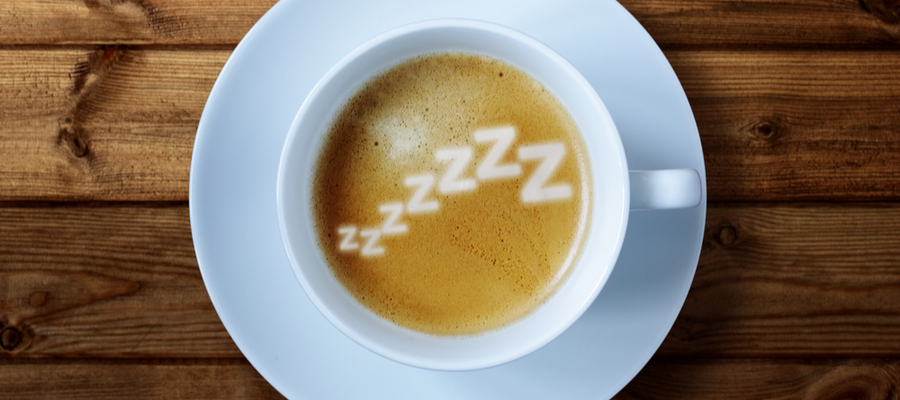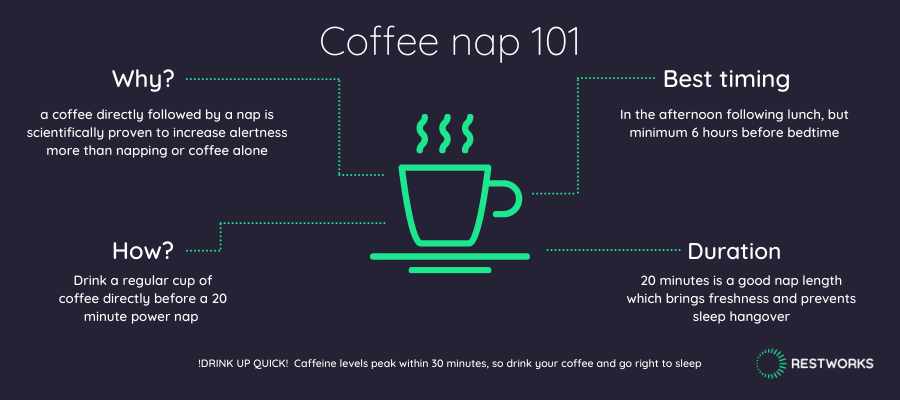What is a Coffee Nap?
A coffee nap – occasionally known as a nappuccino or caffeine nap - is a power nap that combines the rejuvenating effects of napping with the mild stimulant of caffeine.
Initial research suggests that the combination of coffee and nap might create a synergy. This means that you feel more alert and productive from the combination than you would through coffee or a regular nap alone.
Whether or not you have a nap pod at hand, coffee naps can be a great way to dispel afternoon sluggishness and boost performance.
How to take a coffee nap
- Drink a regular cup of coffee immediately before lying down. If you drink coffee too long ahead, the caffeine will kick in too soon and prevent you from sleeping.
- Find a good napping spot. It should be quiet, cool, and not too bright.
- Nap for 15-20 minutes. Researchers agree that 20 minutes is the “sweet spot” for nap length, though as little as 6 minutes has benefits. A 20-minute power nap will allow you to rest, but not fall into a deep sleep. This way, you wake up without a “sleep hangover”.
- Wake up and feel fresh! After a 20-minute nap, your sleep pressure will diminish, and your cognitive abilities will be improved. At the same time, the caffeine in your blood will be rising towards peak levels, providing an extra boost of energy. Time to get some work done!

Best time to take a coffee nap
As with a regular power nap, coffee naps are most welcome in the afternoon. This is where there is a natural dip in your circadian rhythm causing grogginess.
In the afternoon, no matter how much coffee or other caffeinated beverage you drink, you will still have the dip in your circadian rhythm. Therefore the best approach is to simply listen to your body and take a short nap. In this instance, you combine the nap with a little caffeine.
While a coffee nap generally works great in the afternoon, you can also benefit from it at other times during the day. For example before exercise or exams, or at midday if you haven’t slept well the night before.
Night shift workers may also benefit from a coffee nap. Either you can take one before the start of a shift, or during the shift to stay alert.
While coffee naps can come in handy at many points during the day, it is recommended that you refrain from caffeine six hours before bedtime, as this can disrupt your sleep and cause sleep apnea.
The science behind coffee naps

The effects of drinking coffee before a nap have not been researched exhaustively. However, what research has been done so far suggests a synergy.
Researchers at Loughborough University in the UK conducted a small study (12 participants) using a car driving simulation. They found that those who had both ingested caffeine and had a nap showed significant improvement over control subjects who only had a nap or caffeine, or neither a nap or caffeine.
Another study of ten young people compared the alerting effects of (a) naps, (b) caffeine followed by a nap, (c) being exposed to bright light after napping, (d) face washing after naps, and (e) short, no sleep rests. Again, the caffeine and nap combination scored the highest (followed closely by the combination of a nap + bright light).
Caffeine and sleep

The reason why a coffee nap can be more refreshing than a regular power nap might be explained by looking at the organic compound adenosine. Adenosine increases in our bodies when we are tired. Once we fall asleep, our levels of adenosine decline.
Interestingly, caffeine works as an antagonist of adenosine, since it competes with adenosine for receptors. This is why caffeine causes us to feel more alert.
Because adenosine levels are already low after a nap, the caffeine molecules will in theory have an easier time blocking receptors.
In other words, the caffeine effect will improve, and this might be the key to explaining why coffee naps are more effective than regular power naps.
While the coffee before nap strategy can work like a dream, the relationship between caffeine and sleep is far from harmonic. In fact, caffeine is one of the most common causes of insomnia, along with stress.
Too much caffeine can keep you from getting the sleep you need. This in turn can lead to higher consumption of coffee the following day. In this way, over-use of caffeine and sleep deprivation can become a vicious circle.
It is recommended to stop caffeine intake 6 hours before bedtime. In this way, there will be time for the caffeine to leave your system. Caffeine has a half-life of up to 5 hours, but effects peak at about 30-60 minutes after consumption.
How much caffeine is in coffee?

In case you’re wondering how much caffeine is contained in coffee, it is about 80-135 mg for a regular cup of joe, and up to 500 mg for specialty coffee.
It should be noted that caffeine levels can vary considerably. Much depends on brewing technique and the amounts of coffee beans used. Even using the same beans and brewing method, caffeine levels may vary, so this is something to take into account.
The recommended maximum daily intake of caffeine is 400 mg, amounting to about 4 cups of regular coffee. However, there are also many other substances than coffee that contain caffeine.
Caffeine alternatives to coffee
If drinking coffee is not your thing, you can still take a coffee nap by getting your caffeine kicks elsewhere. Here are a few suggestions for brews and supplements that pack a punch big enough for a caffeine nap:
Tea
Depending on the type, tea can pack a fair amount of caffeine. Black tea and oolong teas tend to have the highest caffeine content.
Matcha
Matcha is a healthy green tea drink with lots of antioxidants. It also has a large amount of caffeine which makes it suitable for a caffeine nap.
Maté
Yerba maté is a bitter, tea-like beverage that is often enjoyed in countries like Argentina and Chile. Traditionally, it is consumed from a calabash gourd with a straw. It can also be purchased in tea bags. Prepared correctly, maté will contain almost as much caffeine as a cup of coffee, so this is another great candidate for a coffee nap.
Guarana
If you are looking for a strong caffeine booster that can be quickly ingested, guarana might be for you. The seeds of guarana berries contain about twice the amount of caffeine found in coffee seeds. Most people take guarana in pill form, but it is also commonly found in energy drinks and soft drinks.
Cocoa
For thousands of years, cocoa has been treasured as the food of the gods. Whether you ingest cocoa as chocolate or in a drink, it contains the stimulant theobromine, as well as a lesser amount of caffeine. Running low on energy? – Try a piece of dark chocolate instead of drinking coffee.
Coffee naps in brief
A coffee nap is a short, 20-30 minutes power nap preceded by a cup of coffee, corresponding to roughly 100 mg of caffeine. The combination of power nap and caffeine seems to have a synergy effect that can benefit cognitive performance.
The best time of the day to have a coffee nap is in the afternoon when you experience a natural dip in your energy. It is good advice to be limiting coffee naps six hours before bedtime, so if you feel a dip in the late evening, stick with a regular power nap.


